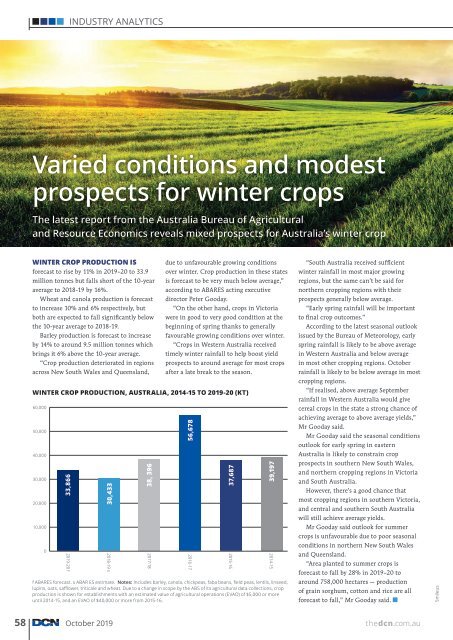DCN October Edition 2019
You also want an ePaper? Increase the reach of your titles
YUMPU automatically turns print PDFs into web optimized ePapers that Google loves.
INDUSTRY ANALYTICS<br />
Varied conditions and modest<br />
prospects for winter crops<br />
The latest report from the Australia Bureau of Agricultural<br />
and Resource Economics reveals mixed prospects for Australia’s winter crop<br />
WINTER CROP PRODUCTION IS<br />
forecast to rise by 11% in <strong>2019</strong>–20 to 33.9<br />
million tonnes but falls short of the 10-year<br />
average to 2018-19 by 16%.<br />
Wheat and canola production is forecast<br />
to increase 10% and 6% respectively, but<br />
both are expected to fall significantly below<br />
the 10-year average to 2018-19.<br />
Barley production is forecast to increase<br />
by 14% to around 9.5 million tonnes which<br />
brings it 6% above the 10-year average.<br />
“Crop production deteriorated in regions<br />
across New South Wales and Queensland,<br />
due to unfavourable growing conditions<br />
over winter. Crop production in these states<br />
is forecast to be very much below average,”<br />
according to ABARES acting executive<br />
director Peter Gooday.<br />
“On the other hand, crops in Victoria<br />
were in good to very good condition at the<br />
beginning of spring thanks to generally<br />
favourable growing conditions over winter.<br />
“Crops in Western Australia received<br />
timely winter rainfall to help boost yield<br />
prospects to around average for most crops<br />
after a late break to the season.<br />
WINTER CROP PRODUCTION, AUSTRALIA, 2014-15 TO <strong>2019</strong>-20 (KT)<br />
60,000<br />
50,000<br />
40,000<br />
30,000<br />
20,000<br />
10,000<br />
0<br />
33,866<br />
<strong>2019</strong>-20 f<br />
30,433<br />
2018-19 s<br />
38, 396<br />
2017-18<br />
f ABARES forecast. s ABAR ES estimate. Notes: Includes barley, canola, chickpeas, faba beans, field peas, lentils, linseed,<br />
lupins, oats, safflower, triticale and wheat. Due to a change in scope by the ABS of its agricultural data collections, crop<br />
production is shown for establishments with an estimated value of agricultural operations (EVAO) of $5,000 or more<br />
until 2014-15, and an EVAO of $40,000 or more from 2015-16.<br />
56,678<br />
2016-17<br />
37,687<br />
2015-16<br />
39,197<br />
2014-15<br />
“South Australia received sufficient<br />
winter rainfall in most major growing<br />
regions, but the same can’t be said for<br />
northern cropping regions with their<br />
prospects generally below average.<br />
“Early spring rainfall will be important<br />
to final crop outcomes.”<br />
According to the latest seasonal outlook<br />
issued by the Bureau of Meteorology, early<br />
spring rainfall is likely to be above average<br />
in Western Australia and below average<br />
in most other cropping regions. <strong>October</strong><br />
rainfall is likely to be below average in most<br />
cropping regions.<br />
“If realised, above average September<br />
rainfall in Western Australia would give<br />
cereal crops in the state a strong chance of<br />
achieving average to above average yields,”<br />
Mr Gooday said.<br />
Mr Gooday said the seasonal conditions<br />
outlook for early spring in eastern<br />
Australia is likely to constrain crop<br />
prospects in southern New South Wales,<br />
and northern cropping regions in Victoria<br />
and South Australia.<br />
However, there’s a good chance that<br />
most cropping regions in southern Victoria,<br />
and central and southern South Australia<br />
will still achieve average yields.<br />
Mr Gooday said outlook for summer<br />
crops is unfavourable due to poor seasonal<br />
conditions in northern New South Wales<br />
and Queensland.<br />
“Area planted to summer crops is<br />
forecast to fall by 28% in <strong>2019</strong>–20 to<br />
around 758,000 hectares — production<br />
of grain sorghum, cotton and rice are all<br />
forecast to fall,” Mr Gooday said.<br />
Smileus<br />
58 <strong>October</strong> <strong>2019</strong><br />
thedcn.com.au
















